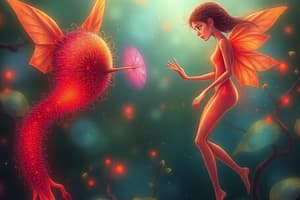Podcast
Questions and Answers
What is the main difference between asexual and sexual reproduction?
What is the main difference between asexual and sexual reproduction?
- Sexual reproduction produces genetically identical offspring.
- Asexual reproduction results in genetically identical offspring. (correct)
- Asexual reproduction requires two parents.
- Sexual reproduction does not involve gametes.
Budding is a method of sexual reproduction.
Budding is a method of sexual reproduction.
False (B)
Which of the following environmental factors does NOT significantly influence reproduction?
Which of the following environmental factors does NOT significantly influence reproduction?
- Human intervention (correct)
- Water availability
- Food availability
- Presence of predators
What is the result of fertilization in sexual reproduction?
What is the result of fertilization in sexual reproduction?
Temperature has no effect on reproductive processes.
Temperature has no effect on reproductive processes.
In meiosis, gametes are produced which are ______.
In meiosis, gametes are produced which are ______.
Match the following asexual reproduction methods with their descriptions:
Match the following asexual reproduction methods with their descriptions:
What are the different stages included in the life cycle of an organism?
What are the different stages included in the life cycle of an organism?
The availability of __________ can directly influence reproductive success.
The availability of __________ can directly influence reproductive success.
Which of the following is NOT a method of asexual reproduction?
Which of the following is NOT a method of asexual reproduction?
Which of the following is a factor that can affect competition for mates?
Which of the following is a factor that can affect competition for mates?
The transmission of genetic material is not necessary for a species' continuation.
The transmission of genetic material is not necessary for a species' continuation.
Match the stage of the life cycle with its description:
Match the stage of the life cycle with its description:
Why is genetic variation important in offspring produced through sexual reproduction?
Why is genetic variation important in offspring produced through sexual reproduction?
In sexual reproduction, the male and female gametes unite during ______.
In sexual reproduction, the male and female gametes unite during ______.
Variations from asexual reproduction contribute heavily to evolution.
Variations from asexual reproduction contribute heavily to evolution.
Competition for __________ can significantly affect successful reproduction.
Competition for __________ can significantly affect successful reproduction.
What regulates the rate of reproduction in species?
What regulates the rate of reproduction in species?
What role does photoperiod play in reproduction?
What role does photoperiod play in reproduction?
Which of the following best describes the relationship between reproductive success and evolution?
Which of the following best describes the relationship between reproductive success and evolution?
Flashcards
Asexual Reproduction
Asexual Reproduction
Reproduction from one parent, creating genetically identical offspring.
Sexual Reproduction
Sexual Reproduction
Reproduction involving two parents, creating genetically varied offspring.
Gamete
Gamete
A sex cell (sperm or egg), haploid (single set of chromosomes).
Meiosis
Meiosis
Signup and view all the flashcards
Fertilization
Fertilization
Signup and view all the flashcards
Zygote
Zygote
Signup and view all the flashcards
Budding
Budding
Signup and view all the flashcards
Fragmentation
Fragmentation
Signup and view all the flashcards
Spore Formation
Spore Formation
Signup and view all the flashcards
Vegetative Propagation
Vegetative Propagation
Signup and view all the flashcards
Environmental factors on reproduction
Environmental factors on reproduction
Signup and view all the flashcards
Resource availability
Resource availability
Signup and view all the flashcards
Temperature and climate
Temperature and climate
Signup and view all the flashcards
Predators and diseases
Predators and diseases
Signup and view all the flashcards
Photoperiod
Photoperiod
Signup and view all the flashcards
Competition for mates
Competition for mates
Signup and view all the flashcards
Life cycle stages
Life cycle stages
Signup and view all the flashcards
Reproductive patterns
Reproductive patterns
Signup and view all the flashcards
Evolution and Reproduction
Evolution and Reproduction
Signup and view all the flashcards
Sexual Reproduction and Evolution
Sexual Reproduction and Evolution
Signup and view all the flashcards
Study Notes
Relationship between Reproduction and Life
- Reproduction is a fundamental characteristic of all living organisms. It ensures the continuation of species across generations.
- Various mechanisms exist for reproduction, spanning asexual and sexual modes. Asexual reproduction involves a single parent, resulting in genetically identical offspring. Sexual reproduction, conversely, involves the fusion of gametes (sperm and egg) from two parents, leading to genetically diverse offspring.
Asexual Reproduction
- Asexual reproduction methods include budding, fragmentation, spore formation, and vegetative propagation.
- Budding involves the development of a new organism from an outgrowth or bud on the parent.
- Fragmentation occurs when an organism breaks into fragments, each fragment developing into a new complete organism.
- Spore formation is a method of reproduction where specialized cells called spores are produced. When favourable conditions arise, these spores germinate and grow into new individuals.
- Vegetative propagation involves the development of new plants from vegetative parts of the parent plant, such as stems, roots, or leaves.
Sexual Reproduction
- Sexual reproduction involves the fusion of male and female gametes, leading to genetic variation in offspring. Gametes are typically produced through meiosis, a specialized cell division process.
- Gametes are haploid (containing only one set of chromosomes), while the parent organisms are diploid (containing two sets of chromosomes).
- Fertilization is the process where male and female gametes unite to form a zygote, a diploid cell.
- The zygote then undergoes mitosis, a process of cell division that produces genetically identical cells, leading to the development of a new organism.
Importance of Reproduction for Life
- Reproduction is essential for the survival of a species. Without reproduction, a species will eventually become extinct.
- Variation in offspring produced via sexual reproduction is crucial for adaptation and evolution.
- Reproduction involves the transmission of genetic material from one generation to the next, carrying information encoded in the DNA molecules about the organism's structure, function, and characteristics.
- The rate of reproduction can differ significantly across various species and depends on factors such as the environment and resource availability.
Environmental Factors Affecting Reproduction
- Environmental factors can significantly influence the reproductive success of organisms.
- Availability of resources like food, water, and shelter is vital for reproduction.
- Temperature and climate can also affect reproductive processes and timing.
- Presence of predators or diseases can impact the success rate of offspring production.
- Light duration, influencing photoperiod, can affect reproductive cycles.
- Competition for mates can be a critical factor for successful reproduction, affecting the chances of survival of different species.
Life Cycle and Reproduction
- The life cycle of an organism describes the sequence of stages from birth to reproduction and death.
- Life cycles can vary drastically among different species, from simple to complex patterns.
- Organisms may exhibit different reproductive patterns during their life cycle.
- Many organisms have distinct stages, with specific roles in their life cycle, including growth, development, and reproduction.
Relation to Evolution
- Reproductive success and the ability to adapt to environmental changes are crucial factors in the process of evolution.
- Variations arising from sexual reproduction can favour organisms better equipped to survive and reproduce in changing environments. This driving force in evolution is a key factor behind the diversity of life forms.
Studying That Suits You
Use AI to generate personalized quizzes and flashcards to suit your learning preferences.




